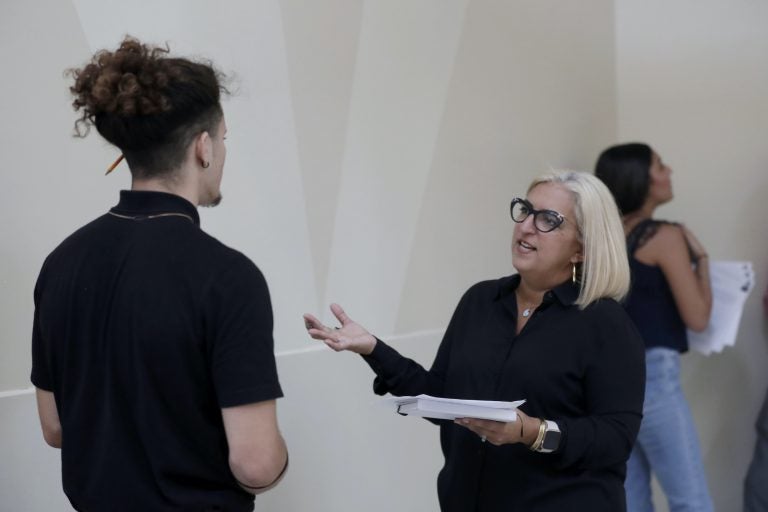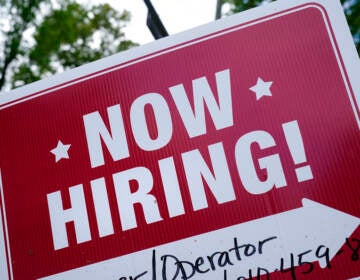Healthy U.S. job market: How big a political edge for Trump?
The strong job growth gives President Donald Trump more evidence for his assertion that the economy is flourishing under his watch.

In this Oct. 1, 2019, photo, Gory Rodriguez, of Starbucks, right, interviews a job applicant during a job fair at Dolphin Mall in Miami. On Wednesday, Jan. 8, 2020 payroll processor ADP reports on how many jobs its survey estimates U.S. companies added in December. (Lynne Sladky/AP Photo)
U.S. hiring jumped last month, and many more people were encouraged to look for work, showing that the economy remains robust despite threats from China’s viral outbreak, an ongoing trade war and struggles at Boeing.
The strong job growth gives President Donald Trump more evidence for his assertion that the economy is flourishing under his watch. It may also complicate the argument his Democratic presidential rivals are making that the economy isn’t benefiting everyday Americans.
The Labor Department said Friday that employers added a robust 225,000 jobs in January. At the same time, a half-million Americans, feeling better about their job prospects, streamed into the job market. Most found jobs. But those that didn’t were newly counted as unemployed, and their numbers raised the jobless rate to 3.6% from December’s half-century low of 3.5%.
Seven Democratic presidential candidates were to debate later Friday in New Hampshire. Leading contenders, notably Sens. Bernie Sanders and Elizabeth Warren, have built campaigns around the argument that the middle class has been mostly left out of an economic expansion that has disproportionately served the wealthy.
The outcome of the presidential race could hinge in part on whether enough voters agree that inequality and rising costs for services such as health care, housing and college education outweigh the benefits from nearly 11 years of economic growth.
“Democratic primary voters are very open to messages about the economy doing badly,” said Jason Furman, a top economic adviser to former President Barack Obama, said.
Furman added, though, “I don’t know that that would be consistent for the electorate as a whole.”
As the election intensifies, views of the economy remain broadly polarized. According to a Pew Research Center survey released Friday, 81% of Republicans and Republican-leaning independents say the economy is excellent or good. Only 39% of Democrats and those leaning Democratic say so.
The public overall, Pew notes, holds a more positive view of the economy than at any point in the past 20 years. Fifty-seven percent say they think it is excellent or good, up from 32% in 2016.
Trump and his team can point to several positive trends in Friday’s jobs report, though his Democratic opponents can cite some evidence for their contrasting views, too.
Robust hiring has picked up from earlier this year, when the trade war with China raged, and is helping remedy one of the economy’s key weaknesses: Even as the unemployment rate fell from a peak of 10% in 2009, millions of Americans were discouraged about finding a job and stopped looking for one. Some returned to school or stayed home to care for relatives.
Yet that trend has nearly reversed itself since 2016. The proportion of Americans in their prime working years — ages 25 through 54 — who either have a job or are looking for one has reached its highest point since September 2008, just before the recession intensified. Economists typically focus on the prime-age population because it filters out the effects of retirement among the vast baby boomer generation.
Trump officials are also stressing that the job market is now benefiting a wider range of demographic groups.
“We have seen Hispanics, African Americans, Asians, young people, women — all … are either at their all-time employment lows or very nearly so,” Larry Kudlow, the White House’s top economic adviser, said Friday.
Trump has also been touting a “blue collar boom,” though the evidence for that is mixed. Manufacturers lost jobs in January for the third time in four months. The employment report shows that if there is such a boom, it is among construction and transportation and warehouse workers, who accounted for nearly one-third of last month’s hiring. These jobs often pay less than factory jobs of the past.
Wages are also a mixed bag. Hourly pay rose 3.1% in January from a year earlier, a decent pace but below a peak of 3.5% reached last summer. The last time the unemployment rate fell below 4%, in the late 1990s, wages were rising much faster — about 4.5% annually.
Still, pay is picking up for many low-income workers, a trend that Trump has repeatedly pointed to. For the poorest one-quarter of workers, wages rose 4.6% year-over-year in December, the most recent month for which data is available, compared with 3% for the richest quarter, according to the Federal Reserve Bank of Atlanta.
Those outsize gains began in 2015 and have been fueled in part by higher minimum wages in many states.
Yet there are many soft spots in the economy that Democrats can work with, Furman said. For example, a Congressional Budget Office report in December concluded that Trump’s 2017 tax cuts disproportionately benefited wealthy Americans. The CBO, a nonpartisan institution, forecasts that the richest 1% of Americans will enjoy roughly triple the gains in after-tax income compared with the bottom fifth.
Nor has the economy’s growth reversed long-running wealth disparities. Federal Reserve data shows the top 1% owned more than 32% of the nation’s housing and financial wealth, up slightly from when Trump was inaugurated.
Despite the economic strength evident in Friday’s job report, analysts warn that hiring could slow in the coming months. January’s jobs report was compiled before the spread of the coronavirus, which has sickened thousands in China, closed stores and factories there and led many international businesses to suspend operations involving China.
And Boeing’s decision to halt production of its troubled 737 MAX appear to has yet to affect overall job growth. But some Boeing suppliers have announced layoffs that could be felt in next month’s jobs report.
WHYY is your source for fact-based, in-depth journalism and information. As a nonprofit organization, we rely on financial support from readers like you. Please give today.




